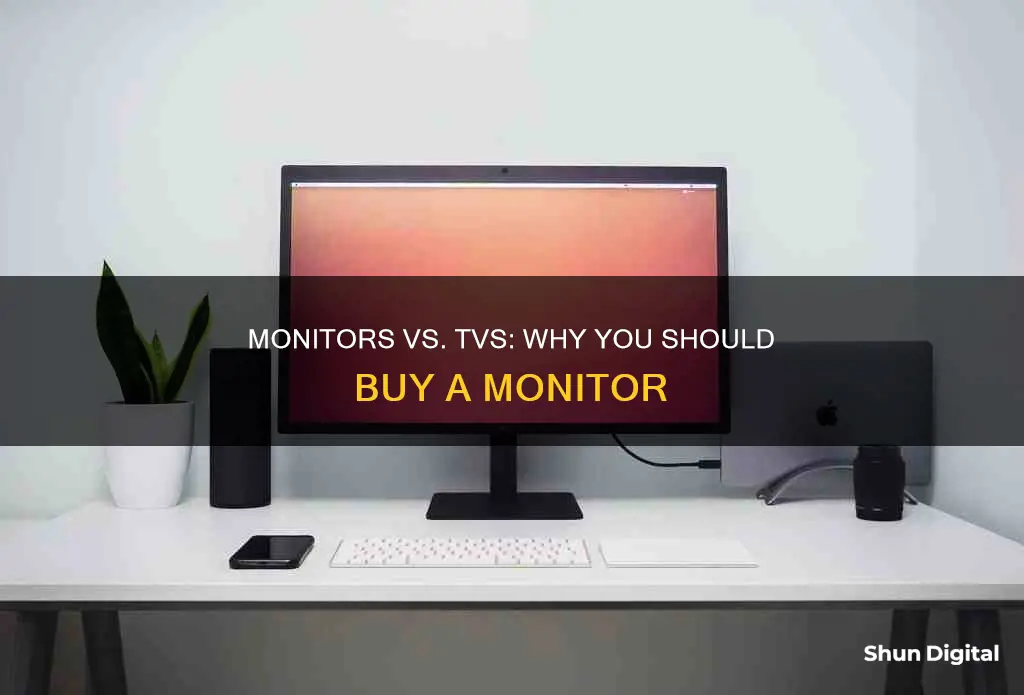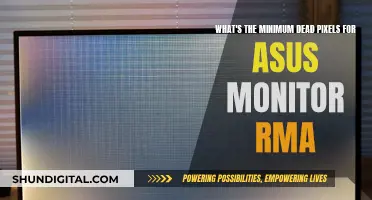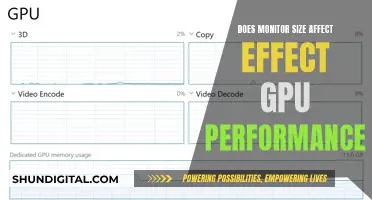
When it comes to choosing between a TV and a monitor, it's important to consider your specific needs and preferences. While both screens can serve similar functions, they have distinct features that set them apart. One of the main factors to consider is the intended use. If you're looking for a general display for personal use, such as browsing the internet or working from home, a monitor is likely the better option. On the other hand, if you want a media centre to replace your old TV or for family entertainment, a big-screen TV might be more suitable.
| Characteristics | Values |
|---|---|
| Purpose | Monitors are better for computers and gaming; TVs are better for media and family use |
| Display | Monitors have better picture quality, but TVs are bigger |
| Price | TVs are generally cheaper for the same resolution |
| Features | TVs have more built-in features like DVD players and smart capabilities |
| Flexibility | Monitors have more variety in aspect ratios; TVs have more ports |
| Sound | TVs often have built-in speakers, monitors sometimes do |
| Use case | Monitors are better for close-up work; TVs are better for large spaces |
What You'll Learn
- Monitors have lower input lag, making them better for gaming
- TVs are more affordable and larger, making them better for movies and TV shows
- Monitors have higher resolutions, making them better for detailed images and videos
- TVs have more ports, making them more flexible
- Monitors have faster response times, making them better for fast-paced scenes

Monitors have lower input lag, making them better for gaming
When it comes to gaming, monitors have several advantages over TVs. One of the most significant is their lower input lag, which refers to the time it takes for the signal received by the display to be processed and shown on the screen.
Televisions often rely on filters that enhance image quality for TV viewing, such as noise reduction and upscaling. While these filters improve the viewing experience for TV watchers, they introduce extra processing time, resulting in input lag. In contrast, monitors take the digital signal from a console and send it directly to the screen with minimal processing, providing a quicker visual response to controller inputs.
The impact of input lag is a noticeable delay between button presses and the corresponding actions on the screen. This delay can negatively affect the gaming experience, especially for competitive gamers or those seeking the best performance. The rule is simple: the lower the input lag, the better. Monitors typically offer input lag of around 10 milliseconds, while TVs, even those with a dedicated "Game Mode", often struggle to achieve similar levels of low input lag.
In addition to lower input lag, monitors also offer faster response times and higher refresh rates than TVs. These factors contribute to a smoother and more responsive gaming experience on monitors, making them the preferred choice for serious PC gamers.
Setting Up Studio Monitors: A Step-by-Step Guide
You may want to see also

TVs are more affordable and larger, making them better for movies and TV shows
When it comes to choosing between a TV and a monitor, it's important to consider your specific needs and preferences. While both can serve similar functions, there are key differences that set them apart.
One significant advantage of TVs is their larger screen size, which ranges from 19 to 85 inches or even larger. This bigger screen size enhances the viewing experience, especially when watching movies and TV shows. In contrast, monitors typically offer smaller screen sizes, usually ranging from 15 to 50 inches, making them more suitable for personal use or in spaces with limited room.
Additionally, TVs are generally more affordable than monitors. For the same price, you can often get a larger screen size or better resolution with a TV. This affordability makes TVs a cost-effective option for those seeking a media center or a screen for console gaming.
Moreover, TVs often come with built-in features that enhance their functionality. Many TV models include built-in speakers, and some even have DVD players or other integrated features, providing added convenience and eliminating the need for external devices.
While monitors may offer advantages in certain areas, such as higher refresh rates and faster response times, TVs excel in delivering an immersive viewing experience for movies and TV shows. Their larger screen sizes and affordability make them a compelling choice for home entertainment.
Asus Monitor Manufacturers: Who Makes These Devices?
You may want to see also

Monitors have higher resolutions, making them better for detailed images and videos
When it comes to choosing between a monitor and a TV, there are several factors to consider, including resolution, size, price, functionality, and purpose. While both screens can perform similar functions, there are specific differences that set them apart.
Monitors typically offer higher resolutions than TVs, which means they can display more detailed images and videos. This is especially important if you're looking for a screen for your home office or bedroom, or if you work in a field that requires precise colour accuracy, such as image and video editing. For example, while TVs are available in Full HD and 4K UHD resolutions, monitors offer an in-between option called QHD with 2560×1440 pixels, providing sharper images and text. Additionally, there are ultra-wide monitors with 21:9 and 32:9 aspect ratios for a more immersive viewing experience.
The higher resolution of monitors is particularly noticeable when viewed up close, as the pixel density (the relation between screen resolution and size) is higher. This means that small items on the screen, such as text and icons, will appear clearer and sharper when viewed from a close distance. This is why monitors are generally preferred for computer work, as they provide a sharper image when viewed from a typical computer desk setup.
Furthermore, monitors often have higher refresh rates than TVs, which means they can display images and videos more smoothly. This is especially beneficial for gaming, as it provides a more responsive and fluid experience, reducing motion blur and ghosting. Monitors also tend to have faster response times, which is another important factor for gaming, as it prevents blurring and ghosting during fast-paced scenes.
While TVs may offer larger screen sizes and be more affordable, monitors excel in providing higher resolutions, smoother refresh rates, and faster response times. These features make monitors ideal for detailed images and videos, computer work, and gaming, ensuring a clearer and more responsive viewing experience.
Enhancing Acer LCD Monitor Brightness Settings
You may want to see also

TVs have more ports, making them more flexible
When it comes to flexibility, TVs have the upper hand. They usually have more HDMI, VGA, USB, DVI, and coaxial ports, which means you can connect more devices. This is especially useful if you want to connect a PlayStation, Blu-ray player, or use it as a monitor for online gaming. TVs also offer a coaxial cable and a port for an antenna, which computer monitors do not.
While monitors may have similar options, they generally have fewer ports. However, the advantage of using a monitor is that it can be expanded using adaptors and bridges. The most common ports on monitors are VGA, DVI, USB, and HDMI.
If you're looking for something that can serve different purposes and connect to multiple devices, a TV is a more flexible option.
Additionally, TVs are typically larger in size, making them ideal for watching movies and TV shows, as well as console gaming, especially if you're sitting further away from the screen. They are also usually more affordable than monitors, so if you're on a budget, a TV might be a better choice.
However, it's worth noting that monitors have some advantages too. They usually have lower input lag, higher refresh rates, and faster response times, making them a better choice for PC gaming or if you spend a lot of time on your computer.
Unlocking 144Hz: Maximizing Your ASUS FHD Monitor
You may want to see also

Monitors have faster response times, making them better for fast-paced scenes
When it comes to fast-paced scenes, monitors have several advantages over TVs. One of the most significant factors is the response time, which refers to how quickly pixels on the display can switch from one colour to another. Monitors typically offer faster response times, resulting in a smoother viewing experience and reducing the chances of ghosting or blurring during fast-moving scenes.
The type of panel technology used in displays also plays a crucial role in response time. Twisted nematic (TN) panels, commonly found in monitors, tend to have the fastest response times, although they may compromise picture quality. On the other hand, in-plane switching (IPS) panels, often used in TVs, offer superior colour accuracy and viewing angles but at the cost of slower response times. Vertical alignment (VA) panels strike a balance between response time and colour reproduction.
In addition to faster response times, monitors also boast higher refresh rates, further enhancing the viewing experience during fast-paced scenes. While TVs typically have a 60Hz refresh rate, monitors can go much higher, with some gaming monitors offering up to 540Hz. This means that monitors can display a significantly higher number of frames per second, resulting in smoother and more fluid visuals.
The combination of faster response times and higher refresh rates makes monitors ideal for gaming, especially for competitive and professional gamers who require minimal input lag and seamless performance. Monitors are designed to provide a direct connection between the console and the screen, resulting in a quick visual response to controller inputs. This is in contrast to TVs, which often rely on image processing techniques that can introduce noticeable delays.
In summary, monitors offer faster response times, higher refresh rates, and lower input lag, making them the preferred choice for fast-paced scenes and gaming. These advantages ensure that viewers can enjoy smooth, blur-free visuals, even during high-action sequences.
Setting Up Dual Monitors on Ubuntu: A Step-by-Step Guide
You may want to see also
Frequently asked questions
Monitors have lower input lag, higher refresh rates and faster response times than TVs, which make them a better choice for gaming.
Monitors tend to pack their pixels into a smaller space, making images sharper. On most televisions, spreadsheets and websites might look fuzzy when they’re up on the screen, but that won’t be the case with a monitor.
While TVs can be cheaper, monitors are more affordable at equal resolution.







